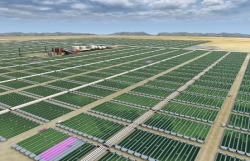Generations of Biofuels
First Generation Biofuels

The Cost of Biofuels!
First Generation biofuels are produced directly from food crops by abstracting the oils for use in biodiesel or producing bioethanol through fermentation[1]. Crops such as wheat and sugar are the most widely used feedstock for bioethanol while oil seed rape has proved a very effective crop for use in biodiesel. However, first generation biofuels have a number of associated problems. There is much debate over their actually benefit in reducing green house gas and co2 emissions due to the fact that some biofuels can produce negative Net energy gains, releasing more carbon in their production than their feedstock’s capture in their growth. However, the most contentious issue with first generation biofuels is ‘fuel vs food’. As the majority of biofuels are produced directly from food crops the rise in demand for biofuels has lead to an increase in the volumes of crops being diverted away from the global food market. This has been blamed for the global increase in food prices over the last couple of years.
Second Generation Biofuels

Second Generation biofuels have been developed to overcome the limitations of first generation biofuels. They are produced from non-food crops such as wood, organic waste, food crop waste and specific biomass crops, therefore eliminating the main problem with first generation biofuels[1]. Second Generation biofuels are also aimed at being more cost competitive in relation to existing fossil fuels[2]. Life cycle assessments of second-generation biofuels have also indicated that they will increase ‘net energy gains’ over coming another of the main limitations of first generation biofuels.
Third Generation Biofuels

Solix Bioreactor
The Third Generation of biofuels is based on improvements in the production of biomass. It takes advantage of specially engineered energy crops such as algae as its energy source[3]. The algae are cultured to act as a low-cost, high-energy and entirely renewable feedstock. It is predicted that algae will have the potential to produce more energy per acre than conventional crops. Algae can also be grown using land and water unsuitable for food production, therefore reducing the strain on already depleted water sources. A further benefit of algae based biofuels is that the fuel can be manufactured into a wide range of fuels such as diesel, petrol and jet fuel.
Fourth Generation Biofuels

Carbon Capture & Storage
Four Generation Bio-fuels are aimed at not only producing sustainable energy but also a way of capturing and storing co2. Biomass materials, which have absorbed co2 while growing, are converted into fuel using the same processes as second generation biofuels. This process differs from second and third generation production as at all stages of production the carbon dioxide is captured using processes such as oxy-fuel combustion[4]. The carbon dioxide can then be geosequestered by storing it in old oil and gas fields or saline aquifers. This carbon capture makes fourth generation biofuel production carbon negative rather then simply carbon neutral, as it is ‘locks’ away more carbon than it produces. This system not only captures and stores carbon dioxide from the atmosphere but it also reduces co2 emissions by replacing fossil fuels.
References
[1] UN Report; Sustainable Bioenergy: A Framework for Decision Makers; April 2007
[2] Review of EU Biofuels Directive; Public consultation exercise; April- July 2006
[3] Chisti Y; Biodiesel from Microalgae; Biotechnology Advances 25 (2007) 294–306
[4] Schmetz E, Ackiewicz M, Tomlinson G, White C, Gray D; Increasing Security and Reducing Carbon Emissions of the U.S. Transportation Sector: A Transformational Role for Coal with Biomass; National Energy Technology Laboratory
[1] UN Report; Sustainable Bioenergy: A Framework for Decision Makers; April 2007
[2] Review of EU Biofuels Directive; Public consultation exercise; April- July 2006
[3] Chisti Y; Biodiesel from Microalgae; Biotechnology Advances 25 (2007) 294–306
[4] Schmetz E, Ackiewicz M, Tomlinson G, White C, Gray D; Increasing Security and Reducing Carbon Emissions of the U.S. Transportation Sector: A Transformational Role for Coal with Biomass; National Energy Technology Laboratory
Picture of The cost of Biofuels courtesy of http://amzuri.wordpress.com/2008/08/03/how-hungry-are-you/
Picture of straw nozzle courtesy of http://www.driving-ideas.de/en/fill_up_with_sun/index.php
Picture of solix bioreactor courtesy of http://www.thetruthaboutcars.com/biodiesel-from-pond-scum/
Picture of Carbon capture and storage courtesy of http://www.geos.ed.ac.uk/masters/ccs_info/facilities.html
Picture of straw nozzle courtesy of http://www.driving-ideas.de/en/fill_up_with_sun/index.php
Picture of solix bioreactor courtesy of http://www.thetruthaboutcars.com/biodiesel-from-pond-scum/
Picture of Carbon capture and storage courtesy of http://www.geos.ed.ac.uk/masters/ccs_info/facilities.html
